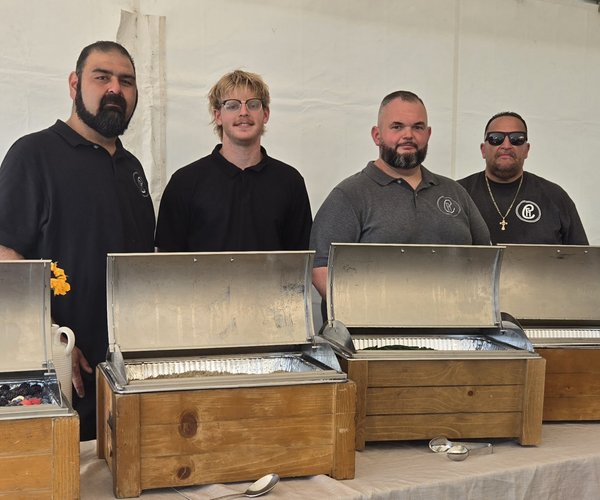Hutton House’s 24-hour crisis line is 526-5544.
The National Runaway Switchboard 24-hour crisis line is 1-800-RUNAWAY or 1-800-786-2929.
For Sheri Epperson the Thanksgiving meal is another reminder that someone is missing from the family dining table. Epperson's son, 17-year-old Travis Tsesmilles, ran away from his Turlock home just over one year ago and despite her best efforts Epperson has not heard one word from her son since that time.
"It's hard to see it reach the one year mark," Epperson said. "The only thing that keeps me going is my faith. I believe God is watching over Travis and taking care of him."
A bright and energetic teen, Travis would often bring home teenage runaways he had befriended, Epperson said. But the loveable and caring Travis that Epperson remembers transformed into someone she barely recognized. It was a change fueled by a growing drug habit, Epperson said.
"I put him into a rehab program and he stayed clean for two and a half months, but then he fell back into it and was out of control again," Epperson said.
Travis' behavior caught the attention of law enforcement and he was arrested one night while hanging out in Donnelly Park. He was sent to Juvenile Hall and later given a sentence of house arrest. Six days into his home detention Travis ran away.
Epperson's efforts to find her son have been ongoing. She filed police reports with both the Turlock and Modesto police departments and keeps in regular contact with them. She spoke to child advocate Mark Klaas for tips on searching for Travis and created a Facebook page. She also held a candlelight vigil on Nov. 17, the day Travis left home. She's heard plenty of rumors about Travis' whereabouts, including one that he was shot to death by a gang member and left in a ditch.
"I believe he is alive and just too ashamed to call right now," Epperson said. "He's got gifts, but he's not using his head right now. I want him to come home and take care of this business, so he can get on with the rest of his life."
Crisis on the rise
The tale of a teenage runaway is hardly original. The National Runaway Switchboard reports between 1.6 million and 2.8 million youth run away in a year.
November is National Runaway Prevention Month.
"From runaway statistics to the number of organizations that can help, numbers tell the story of this silent crisis," said Maureen Blaha, NRS executive director. "We encourage all Americans to pause this November to talk about the issue and realize prevention is possible."
The NRS was originally formed in 1971 in Chicago to serve as a crisis intervention for youth. In 1974 it grew into a national program. Today it operates a 24-hours a day crisis line (1-800-RUNAWAY) and offers information and referrals, conference calls between runaways and their families, message services, free bus rides home, and educational materials.
The hotline handles more than 100,000 calls a year and the rates are increasing. The number of youth calling NRS who had been on the streets for more than six months has increased 70 percent over the last decade. Callers who had been on the streets two to six months increased 48 percent over the last decade.
The NRS also tracks some of the long-term impacts of running away from home. The National Longitudinal Study of Adolescent Health found that youths who run away from home often face daunting obstacles in their adult years. Among the data collected:
• The likelihood of having suicidal thoughts increases by 51 percent. An even stronger relationship is found between suicide attempts and previous runaway experience, with runaways being more than three times as likely as non-runaways to attempt suicide.
• Runaways are 53 percent more likely to report having a sexually transmitted disease as an adult than non-runaways.
• Their annual personal income level is $8,823 lower on average compared to non-runaways.
• They have lower education levels on average than adults who never ran away from home.
• They are approximately two and a half times more likely to be arrested as non-runaways.
The reasons behind a teenager's decision to leave home are as varied as the teenagers themselves. According to the NRS, the most often cited reasons deal with some form of abuse, whether it's mental, physical, or sexual.
The NRS also reports that most runaways make their decision to leave without planning. More than 70 percent of the youth interviewed by NRS said their leaving home was a spur of the moment decision. This may have been the circumstances behind Karissa Schell's disappearance.
‘Living off the radar'
Karissa was last seen by her family on April 21, 2011. According to Turlock Police Detective Tim Redd, Karissa spent the night at her father's home in Turlock after arguing with her mother. Sometime in the early morning hours Karissa slipped out of the house and disappeared into a web of friends and associates. Her whereabouts remain unknown, but just recently Redd learned from some Starr Avenue residents that Karissa was seen in the area as recently as a week ago.
"We believe she is still in the Turlock area and is floating from house to house," Redd said. "She doesn't seem to want to return to her mother. She will turn 18 here in a few weeks and the hope is that she will resurface then. But until then she will probably keep living off the radar."
The concern is that Karissa may have fallen into some criminal activity to survive on her own. The NRS reports that nearly 35 percent of runaway teens make their money by panhandling, while numerous others have had to resort to prostitution, selling drugs and thievery to make money. Redd sincerely hopes Karissa has not had to take that path.
"My main goal is to talk to her and find out if she is OK," Redd said. "We are concerned for her well-being. She doesn't even need to tell us where she's been."
Safe haven
There is another option to life on the streets for local teens like Karissa and Travis. Hutton House operates in Stanislaus County through the Center for Human Services and offers 13 to 17 year olds a temporary shelter and a safety line in a time of crisis.
"It's a place where you can focus on yourself and no one is breathing down your neck," said a 17-year-old boy staying at the house. "You have time to think here."
Hutton House can provide shelter for up to eight teens, but it's the program's day services that have the most impact on area teens and their families. The day services include individual, group and family counseling, parenting classes, help with substance abuse, and if possible reuniting families.
Last year there were 1,416 reported runaways in Stanislaus County, including 239 in Turlock. Of those, 288 spent some time under Hutton House's roof and 533 utilized the day services, said Hutton House Program Manager Valrie Thompson.
The program's ultimate goal is to convince runaways to return home - if it is in their best interest. Of all the runaways Hutton House saw last year 70 percent returned home or went to live with another family member. Some of the remaining will end up in foster care and some will enter substance abuse programs. About 10 percent will decide to return to the streets, Thompson said.
"The reality is some are not going to go back home," Thompson said. "For the others this is a place where they can be believed and someone will support them."
Epperson retains hope that her son Travis won't be one of those that never return home.
"Travis was my life and when he walked out the door he took it with him," Epperson said. "I just want him to know I love him and miss him and want him to come home."









